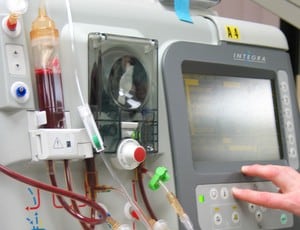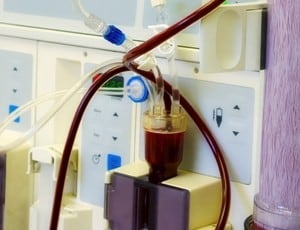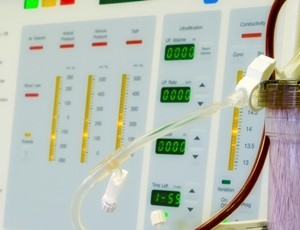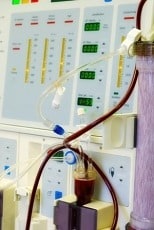Central venous catheter for urgent start haemodialysis

“Prolonged retention of non-cuffed CVC (median 37 days) is common in resource-poor setting” Sathiavageesan et al (2023).
Haemodialysis and CLABSI – Full Text

“Neither catheter salvation nor antibiotic-lock therapy were associated with the recurrence of CRBSI” Ramli et al (2021).
Vascular access service for patients on haemodialysis – Full text

“The prevalence of CVC use was high and there were significant delays to AVF creation” Grant et al (2020).
Factors in haemodialysis that impact on patients’ quality of life

The Vascular Access Questionnaire (VAQ) provides a mechanism for identifying and scoring factors in haemodialysis that impact on patients’ quality of life and perception of their therapy” Field et al (2019). Abstract: BACKGROUND: Haemodialysis is capable of prolonging life in patients with end stage renal disease, however this therapy comes with significant negative impact on […]
Initiation of maintenance hemodialysis through central venous catheters

Despite well-publicized suggestions to utilize arteriovenous fistulae and grafts to initiate hemodialysis, too many patients in the United States start dialysis via central venous catheters” Tang et al (2019). Abstract: BACKGROUND: Despite well-publicized suggestions to utilize arteriovenous fistulae and grafts to initiate hemodialysis, too many patients in the United States start dialysis via central venous […]
Study of tunnelled haemodialysis central line-associated bloodstream infections

We aimed to describe the epidemiology of tunnelled haemodialysis central line-associated bloodstream infections (CLABSI) in an Australian centre” Krishnan et al (2019). Abstract: Infection is a serious complication of tunnelled haemodialysis catheters. We aimed to describe the epidemiology of tunnelled haemodialysis central line-associated bloodstream infections (CLABSI) in an Australian centre. We performed a retrospective audit […]
Vascular access in children requiring maintenance haemodialysis

Here we present clinical practice recommendations for AVFs and CVLs in children with ESKD” Shroff et al (2019). Abstract: BACKGROUND: There are three principle forms of vascular access available for the treatment of children with end stage kidney disease (ESKD) by haemodialysis: tunnelled catheters placed in a central vein (central venous lines, CVLs), arteriovenous fistulas […]
Vascular access-related blood-stream infections among Irish haemodialysis patients

Rates of access-related bloodstream infections (AR-BSI) are influenced by patient characteristics and local protocols. We explored factors associated with AR-BSI in a contemporary cohort of HD patients at a tertiary nephrology centre” Mohamed et al (2019). Abstract: BACKGROUND: Infections are the second leading cause of death and hospitalisation among haemodialysis (HD) patients. Rates of access-related […]
Cost analysis of haemodialysis catheter related bloodstream infection

Catheter related bloodstream infections (CRBSI) represent a complication that often requires hospitalization and the use of economic resources. In Italy, there is no literature that considers the costs of CRBSI for tunneled catheters (CVCt)” Mandolfo et al (2019). Abstract: Catheter related bloodstream infections (CRBSI) represent a complication that often requires hospitalization and the use of […]
Point-of-care ultrasound-guided AVF needle placement

This pilot and feasibility study will assess the feasibility of a randomised controlled trial aimed at evaluating whether POCUS-guided cannulation results in more successful and accurate AVF needle placement than the standard practice of blind cannulation” Schoch et al (2018). Abstract: BACKGROUND: Point-of-care ultrasound (POCUS) has been used in various vascular access contexts; however, to […]
Hepatitis C virus transmission in a Dutch haemodialysis unit

Haemodialysis is a risk factor for hepatitis C virus (HCV) transmission. Two patients receiving haemodialysis in a Dutch dialysis unit in The Hague were found to seroconvert to HCV in December 2016 after the yearly routine control for blood-borne viruses” Heikens et al (2018). Abstract: Background: Haemodialysis is a risk factor for hepatitis C virus […]
Review of a nocturnal home haemodialysis in Australia

The Barwon Health nocturnal home haemodialysis (NHHD) program was established in 2000 as the first formal NHHD program in Australia. We aimed to assess reasons for and factors associated with program exit, and technique and patient survival rates” Choo et al (2018). Abstract: AIM: The Barwon Health nocturnal home haemodialysis (NHHD) program was established in […]
Functional review of precurved non-tunnelled catheters for haemodialysis

Our objective was to assess whether precurved non-tunnelled central venous catheters are comparable to tunnelled central venous catheters in terms of infection and catheter malfunction and to assess whether precurved non-tunnelled catheters are superior to straight catheters” van Oevelen et al (2018). Abstract: BACKGROUND: The main limitations of central venous catheters for haemodialysis access are […]
Hemodialysis using the Cardio-Renal Pediatric Dialysis Emergency Machine

We report the first worldwide experience with continuous veno-venous hemodialysis (CVVHD) in children using the last generation Cardio-Renal Pediatric Dialysis Emergency Machine (CARPEDIEM)TM device” Vidal et al (2018). Abstract: We report the first worldwide experience with continuous veno-venous hemodialysis (CVVHD) in children using the last generation Cardio-Renal Pediatric Dialysis Emergency Machine (CARPEDIEM)TM device. Thirteen children […]
Current status of dialysis and vascular access in Taiwan

However, the statistics and vascular access monitoring are relatively insufficient in the past. The comprehensive integration of vascular access management into public policy related to kidney disease will complete the missing piece of the puzzle of overall care” Chen et al (2018), Abstract: Due to the implementation of the National Health Insurance system in 1995, […]
Translumbar hemodialysis long-term catheter in vascular access failure

Vascular access (VA) in hemodialysis (HD) is essential to end-stage renal disease (ESRD) patients survival. Unfortunately, after some years in HD program, a significant number of patients may develop VA failure for many reasons” Moura et al (2018). Abstract: INTRODUCTION: Vascular access (VA) in hemodialysis (HD) is essential to end-stage renal disease (ESRD) patients survival. […]
Tunneled central venous catheters hemodialysis patient mortality and morbidity

We examined the association between catheter use for maintenance hemodialysis (HD) and mortality/hospitalization in a cohort of patients with prevalent HD” Chiu et al (2018). Abstract: PURPOSE: We examined the association between catheter use for maintenance hemodialysis (HD) and mortality/hospitalization in a cohort of patients with prevalent HD. METHODS: In this study, 70 HD patients […]
Hepatitis C virus infection among haemodialysis patients

These results highlight the potential risk of hepatitis C virus transmission from patients within haemodialysis units in Egypt” Ali et al (2018). Abstract: BACKGROUND AND STUDY AIMS: Hepatitis C virus (HCV) infection is a severe problem among patients on maintenance haemodialysis who are at particular risk for blood-borne infections because of prolonged vascular access and […]
AV fistula complications associated with buttonhole access

In this study, we aimed to investigate whether the choice of cannulation technique – buttonhole with sharp or blunt needles – affected the development of arteriovenous fistula complications” Staaf and Uhlin (2018). Abstract: BACKGROUND: Haemodialysis requires a vascular access, most commonly an arteriovenous fistula, which many patients consider a lifeline. It is important to select […]
Children undergoing hemodialysis – Iranian mothers’ experiences

Nurses are the healthcare team members who most frequently interact with mothers of children undergoing hemodialysis. They are therefore positioned favorably to provide the information and emotional support needed by these mothers” Pourghaznein et al (2018). Abstract: Purpose: To describe Iranian mothers’ perspectives regarding hemodialysis for their children. Design and Methods: This qualitative study was […]

